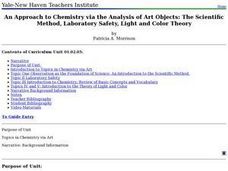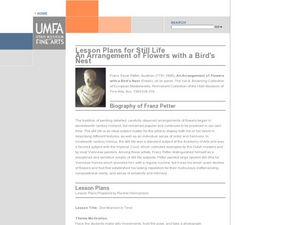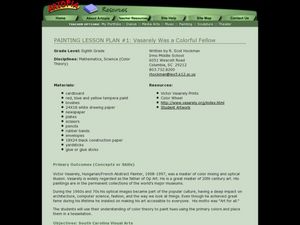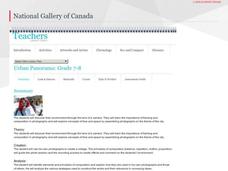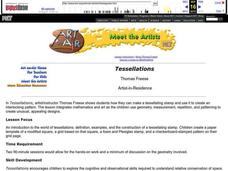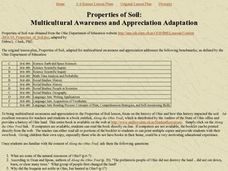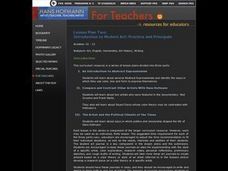Curated OER
Color Theory & Using Layers
Students investigate the color wheel theory and incorporate it into simple sketches on their handheld. The importance of the use of layering and the difference between primary, secondary, and tertiary colors is presented in this lesson.
Fun Music Company
Relative Major and Minor
It's all relative. Young music theorists are asked to count to three and identify the relative major and minor keys of keys that share the same signature.
Classics for Kids
Instruments Have a Family
Are the instruments in Bach's Brandenburg Concerto No. 2 in the same family as those in George Gershwin's Rhapsody in Blue? Elementary musicians work on their music theory and their instrumental ear as they listen to clips of famous...
Curated OER
An Approach to Chemistry via the Analysis of Art Objects: The Scientific Method, Laboratory Safety, Light and Color Theory
Students create a painting that clearly exemplifies the use of primary pigments to make secondary pigments. They demonstrate the distinction between value and saturation. They explain the affect of adjacent colors on each other and...
Curated OER
Keys and Scales are Sets
Music theory lessons can be very tricky for some people. Children with a basic understanding of musical concepts take on the task of transposing music and identifying scale sets. This would be a good topic to address prior to discussing...
Curated OER
One Moment in Time
Students discuss the Mimetic theory and design a still life design in linoleum block. For this Mimetic theory lesson, students discuss the importance of realism in art and research Greek and Roman art forms from which the Mimetic...
Curated OER
Not Your Grandma's Music: A Lesson in Music History
Students experience and discuss the different musical periods such as Baroque, Classical and Romantic. In this music lesson, students discover musical theory and apply it to the Baroque, Classical, and Romantic periods. Students will...
Curated OER
Vasarely Was A Colorful Fellow
Eighth graders create artwork inspired by the work of Victor Vasarely. For this op art lesson, 8th graders explore color theory and color mixing. Students create ten shapes to use in their artwork and over the course of two weeks,...
Curated OER
Color Theory Unit: Tint & Shade Strips
Students create three tint and three shade strips which depict a gradual gradation from color to white and from color to black.
Curated OER
Theoretical Quantum Physics... For Kids!
Learners explore quantum physics by participating in several class activities. In this space-time lesson, students discuss the concepts of time traveling and the anatomy of an atom. Learners draw geometric figures and utilize string to...
Curated OER
True Spin: Music
Upper graders take a critical look at art criticism, music, and politics. They watch one segment of "True Spin," produced by VH1 music television and then discuss myths that relate to art and music. Several modern songs are analyzed...
National Gallery of Canada
Urban Panorama
How can a photographer use images to represent a topic? Over the course of three days, learners discuss various photographs and practice their picture-taking skills with an outdoor, panoramic photography session. They use the images...
Curated OER
Color Theory & Using Layers
Young scholars practice layering colors while creating three distinct backgrounds using the educational software TealPaint in this High School Art and Technology activity. A slideshow, a quiz, and a color PowerPoint Slide show are included.
Curated OER
Dinosaurs 1: Where are the Dinosaurs?
Students study dinosaurs and explore the concept of extinction. In this dinosaur lesson students create dinosaur eggs and view dinosaur dioramas.
National Gallery of Canada
Make a Pinhole Camera
Introduce your class to photography by asking them to construct their own pinhole cameras. After putting together their own devices, pupils take and develop pictures and analyze the results. The plan provides step-by-step instructions...
Peter Nagy
Virtuoso Piano Free 3
This may be as close to playing a piano as it is possible to get without actually having a physical instrument in the class. Learn the names and sounds of keys, play a solo or a duet, and practice scales or any song you'd like–all for free!
Curated OER
Sedimentary Structures- An Adventure in Painting and Collage
Students identify and interpret concepts about how the Earth was formed and convey some of these ideas in a painting.
Students experiment with different types of paints and paint applicators to achieve a variety of visual textures....
Curated OER
Tessellations
Students learn and review basic geometric terms, definitions, and theory, including regular polygons, lines, angles, points, etc. They make a tessellating stamp and create a repeating work of art.
National Gallery of Canada
My First Print
Practice printmaking with a fun lesson. After observing images, class members use the listed materials, such as stamps and sponges, create their own prints. They experiment with layering, pressure, and paint colors.
Curated OER
Color Principles - Hue, Saturation, and Value
Young scholars identify different color models and the application of the color theory. They create different visualizations that compare color models.
Curated OER
Properties of Soil
Students encounter various pieces of knowledge utilizing lessons that addresses a diversity of learners with multiple intelligences. They cover various concepts: science, Earth, scientific inquiry, geometry, data analysis, probability,...
Curated OER
Introduction to Modern Art: Practice and Principals
Students discover the concepts of Abstract Expressionism. They identify Abstract Expressionist paintings and creat an Abstract expressionist work of art.
Curated OER
Cell Organelles
High schoolers explore biology by researching living cells. For this living organism lesson, students participate in a role-playing activity in which all the high schoolers in class form one plant cell by portraying specific parts of a...
Ballet Austin
The History of Modern Dance
The evolution of modern dance, and the dance history of many of the key figures in the development of this uniquely American form, are the focus of a 13-page packet that includes photos of revolutionaries.



